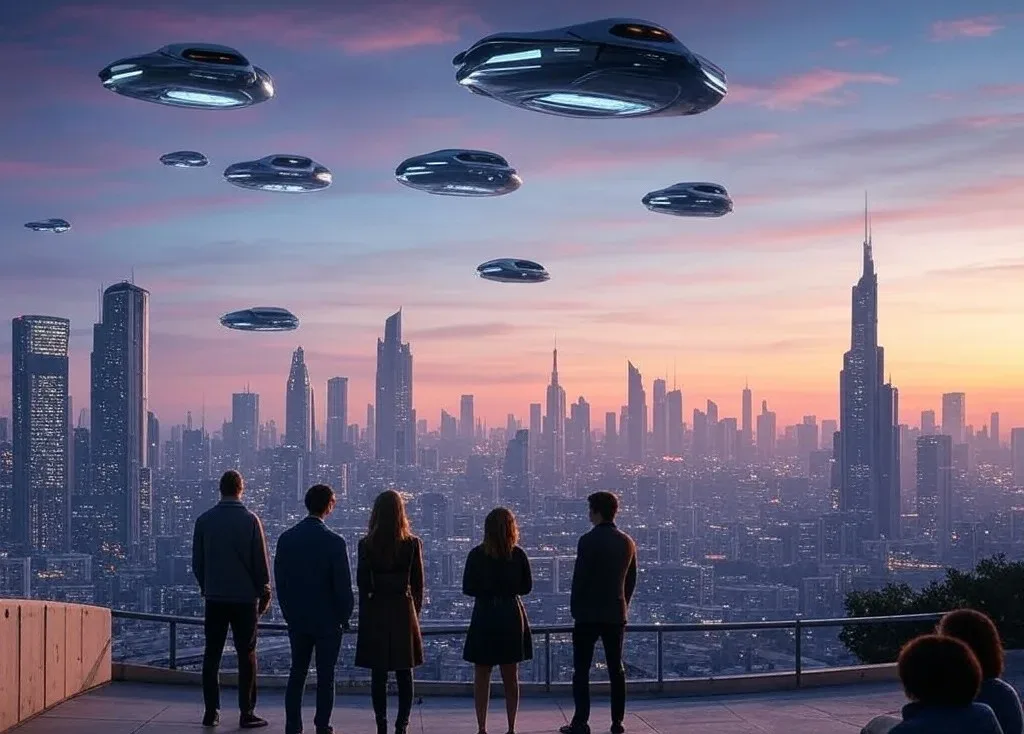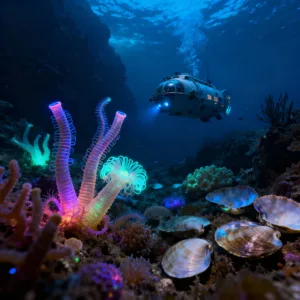
Sci-Fi to Tech
Table of Contents
- Introduction
- The Roots of Imagination in Innovation
- The Evolution of Science Fiction: From Sci-Fi to Tech Dreams
- The Role of Literary Works: From Sci-Fi to Tech Roadmaps
- Cinematic Visions: From Sci-Fi to Tech Inspiration
- The Influence of Video Games: From Sci-Fi to Tech Interfaces
- The Age of AI and Robotics
- Bio-Engineering and Human Enhancement
- Space Exploration: Charting Our Path From Sci-Fi to Tech Realities
- The Need for Ethical Frameworks
- Future Trends and Predictions
- Conclusion
- References
1. Introduction
Imagination drives humanity forward. It feeds our desire to build better tools. It fuels our need to explore unknown frontiers. In this modern era, engineers design devices once considered impossible. They draw inspiration from stories and images that seemed like distant dreams. Visionary writers, filmmakers, and creators shape these dreams. They craft narratives that stretch the limits of possibility.
When people think about advanced technologies, they often picture spaceships and robots. These images once lived only in fictional worlds. Yet, they slowly move From Sci-Fi to Tech as we keep pushing boundaries. Today, we see autonomous cars, smart assistants, and rapid genetic editing. Scientists once read about such wonders in pulp magazines and classic novels. Now, they hold them in their hands.
Moreover, the link between fiction and reality does not end with machines. Complex concepts like cybernetic implants and terraformed planets also find a home in research labs. Indeed, the future blends creativity and science. Step by step, we progress From Sci-Fi to Tech achievements that shape daily life. The creators of old science fiction books never planned to become guides for inventors. Yet, their influence emerges every time a scientist solves a new problem.
This article explores that journey, revealing how imagination shapes innovation. By examining the role of speculative stories, it highlights their influence on guiding engineers. Additionally, examples of impossible dreams transforming into products illustrate this connection. Through careful analysis, we will uncover how each step forward begins with a spark ignited in fictional realms.
2. The Roots of Imagination in Innovation
Imagination sits at the core of progress. It begins with a simple question: “What if?” Inventors often rely on images shaped by fictional tales. They wonder how to solve problems by thinking beyond current limits. This process involves merging creative thought and practical science.
Early innovators looked at the night sky and dreamed of reaching it. They considered flying machines long before anyone took to the air. Although their peers doubted them, they pressed on. Inventions like the airplane showed how a once-impossible vision could become real.
Similarly, inventors consider concepts beyond their era. They find hints in adventurous stories. For example, consider early submarine designs. Writers imagined underwater voyages long before technology allowed them. Eventually, submersible vehicles evolved from rough sketches into working machines.
Engineers also refine old ideas. Sometimes, old fictional stories suggest efficient solutions. Over time, these hints shape modern research. The slow transformation of fantastical ideas into practical tools occurs because creators think without constraints.
Importantly, this path does not follow a simple line. It involves trial, error, and revision. Yet, the initial spark often arises from narrative. Inventors ask themselves how to move From Sci-Fi to Tech by learning from creative sources. They apply scientific principles to concepts first described in fictional worlds. The deeper this process goes, the more intricate the results. In the end, imagination lays down the roadmap. Then, engineers follow that path to bring devices into our everyday routines.
3. The Evolution of Science Fiction: From Sci-Fi to Tech Dreams
Science fiction began as a literary experiment. Early writers used it to imagine worlds beyond their own. Over time, this genre matured. It shifted from simple adventure tales to complex narratives. Authors explored social, political, and technological themes. They tested the limits of human potential.
In these pages, readers found robotic servants, advanced computers, and interstellar travel. Some concepts felt wild and unrealistic. Yet, generations of engineers grew up admiring these visions. As time passed, these dreamers pulled ideas From Sci-Fi to Tech implementations that shaped industries.
A clear pattern emerges if we study the timeline of science fiction. Early stories relied on basic scientific knowledge. Later works incorporated breakthroughs like quantum theory or genetic engineering. Each generation built upon the last. Meanwhile, technological progress raced forward. Ideas that once felt too advanced began to surface in labs.
In the table below, we see examples of fictional ideas influencing actual technologies:
| Fictional Concept | Original Fiction Source | Realized Technology |
|---|---|---|
| Robotic House Helpers | Isaac Asimov’s robot stories | Domestic Robots (e.g., Roomba) |
| Virtual Reality Interfaces | Cyberpunk novels (e.g., Neuromancer) | VR Headsets, Haptic Gloves |
| Interplanetary Travel | Jules Verne’s “From the Earth to the Moon” | Space Probes, Lunar Missions |
As technology marches on, the relationship strengthens. Fiction guides fresh minds. These minds later produce tools that transform daily life. In essence, science fiction seeds innovation. Eventually, these seeds bloom into cutting-edge products.
4. The Role of Literary Works: From Sci-Fi to Tech Roadmaps
Literary works often serve as creative blueprints. Writers detail fantastic inventions and outline new frontiers. Inventors read these stories and think about how to realize similar visions. Over time, these literary guides shape the direction of technology. They help thinkers move From Sci-Fi to Tech breakthroughs.
Consider how Jules Verne inspired explorers of the ocean and sky. His novels described submarines and rockets long before engineers built them. Similarly, H.G. Wells predicted atomic energy and biological engineering. Later generations saw these imagined concepts become reality. Although these authors lacked today’s scientific depth, they planted vital seeds.
Modern literary works continue this legacy. Writers describe quantum computers or advanced biomedical implants. Eventually, researchers work on prototypes. While the details differ, the core concepts can inspire entire fields. This happens even when the final product does not match the original vision. The creative spark still matters.
In fact, literary sci-fi often focuses on societal impacts. Authors show how technology affects culture, ethics, and environment. This helps researchers anticipate problems. They consider not just how to build something but also why and when. Consequently, the process becomes more holistic.
By treating literary works as evolving guides, innovators learn to think broadly. They do not limit their ideas. Instead, they draw on fictional templates and adapt them. Through this process, the line between imagination and engineering blurs. Fictional words become tools that guide real-world solutions.
5. Cinematic Visions: From Sci-Fi to Tech Inspiration
Films and television play a major role in shaping our dreams. Spectacular visuals spark the imagination. They offer vivid portrayals of advanced technology. Viewers watch robotic companions, holographic displays, or warp drives. They wonder if these things can exist outside the screen. Over time, filmmakers’ visions migrate From Sci-Fi to Tech labs where engineers experiment.
For instance, consider the “Star Trek” franchise. It showed handheld communicators and voice-controlled computers decades before smartphones or virtual assistants. Engineers, motivated by these images, explored new interfaces. Eventually, they introduced devices that mirrored the fictional gadgets. Similarly, “Star Wars” inspired robotic arms and prosthetics. These cinematic universes let viewers visualize complexity and detail. This pushes scientists to solve technical puzzles.
Visual storytelling also appeals to a broad audience. Not everyone reads science fiction literature. Yet, many watch blockbuster films. As a result, cinematic sci-fi influences mass perception of future technology. When more people accept an idea, more funding and research follow.
In the table below, we see film-inspired concepts and their real-life counterparts:
| Cinematic Vision | Film/Series | Real-World Technology |
|---|---|---|
| Portable Communicators | “Star Trek” | Smartphones, Wireless Headsets |
| Smart Voice Interfaces | “2001: A Space Odyssey” | Digital Assistants (Alexa) |
| Robot Prosthetics | “Star Wars” | Advanced Bionic Limbs |
Films show possibilities. Researchers then refine these visions. Ultimately, imagination guides technology’s evolution, step by step.
6. The Influence of Video Games: From Sci-Fi to Tech Interfaces
Video games present interactive worlds. They allow players to explore scenarios that feel futuristic. Many designers craft user interfaces that feel intuitive and advanced. As players engage, they demand smoother controls and better realism. Eventually, researchers bring these concepts From Sci-Fi to Tech prototypes that enhance actual devices.
For example, early games introduced heads-up displays and virtual mission maps. Today, engineers integrate augmented reality overlays into helmets for pilots and surgeons. Similarly, gesture-based controls, once limited to fictional spaces, appear in modern user interfaces. Gamers wanted more immersive experiences. In response, hardware developers delivered VR headsets and motion sensors.
Video games also influence artificial intelligence research. Non-player characters rely on algorithms to mimic human behavior. Researchers study these systems to improve real-world AI applications. The lessons learned in game development shape robotics, automation, and natural language processing. Thus, gaming acts as a testing ground.
Moreover, video games encourage problem-solving and creativity. Players face complex puzzles requiring innovative thinking. These experiences teach users how to approach challenges from new angles. As a result, a generation raised on interactive entertainment enters research fields with fresh perspectives.
By examining how interactive media shapes user expectations, innovators find new directions. They adapt gaming elements to real tools and interfaces. Over time, these steps lead to smoother human-machine interactions. In this sense, entertainment does more than amuse. It trains minds, sets standards, and sparks the next generation of technology solutions.
7. The Age of AI and Robotics
Artificial Intelligence and robotics once existed only in dreams. Early depictions portrayed clunky machines or malevolent AI. Yet, scientists dared to shift these images into reality. They moved From Sci-Fi to Tech wonders that now aid in medicine, industry, and daily life. The journey was slow and required many breakthroughs.
For instance, early AI struggled with basic tasks. Today, it solves complex problems. Machine learning models analyze medical images and detect diseases. They power recommendation engines and guide self-driving cars. Robotic arms now assemble products with finesse. Smart drones survey disaster zones and deliver supplies.
As researchers advance AI and robotics, they build upon past visions. Fiction showed humanoid robots with emotional intelligence. Real engineers work toward socially aware robots. These tools could care for the older people, guide the visually impaired, or even teach children. Although not perfect, they improve each year.
Below is a table comparing past fictional visions and current developments in AI and robotics:
| Fictional AI/Robot Feature | Common in Early Sci-Fi | Current Real-World Status |
|---|---|---|
| Emotional Robot Companions | “I, Robot” by Asimov | Early Social Robots, Limited Empathy |
| Automated Factory Workers | Various Futuristic Novels | Widespread Industrial Automation |
| Intelligent Personal Assistants | Many Sci-Fi Universes | Digital Assistants (Siri, Google) |
As time passes, these systems integrate deeper into society. People will trust them more, and industries will adopt them widely. Eventually, the line between imagination and engineered solutions fades.
8. Bio-Engineering and Human Enhancement
Bio-engineering pushes boundaries once left to the imagination. Visionaries envisioned genetic editing, cybernetic limbs, and cognitive enhancements. Today, scientists bring these ideas From Sci-Fi to Tech labs. They use advanced tools like CRISPR to modify genes and fight diseases. Prosthetics connected to nerve endings restore lost movement. Artificial organs help patients live longer.
In the past, novels described super-soldiers or perfect humans with enhanced traits. While reality differs, researchers now explore safe methods to boost human abilities. They might enhance memory or improve resistance to disease. They aim to repair defects instead of merely making “superhumans.” Yet, the influence of past stories lingers. Many researchers admit that fiction inspired their career choices.
Ethical considerations also arise. Changing human biology can have unforeseen effects. Society must decide which enhancements seem acceptable. They must also ensure fair access. Without careful planning, advanced enhancements could create inequality. Therefore, the interplay of imagination and science must be guided by ethical debate.
Bio-engineering also involves biomaterials and tissue printing. Fiction once showed regrowing limbs overnight. Today, scientists grow tissues in labs. These partial solutions hint at a future where missing parts can be replaced. Although progress remains slow, the direction seems clear.
Step by step, researchers refine techniques. They study cells, decode DNA, and shape tissues. They merge fiction’s bold ideas with practical methods. Over time, these efforts transform healthcare and human potential, bringing tomorrow’s medicine closer to today’s patients.
9. Space Exploration: Charting Our Path From Sci-Fi to Tech Realities
Space exploration stands as a prime example of ideas migrating From Sci-Fi to Tech achievements. Writers described lunar colonies and Martian outposts long before rockets existed. They imagined interstellar travel when humanity struggled to reach the clouds. Today, satellites circle Earth. Rovers roam Mars. Space agencies prepare missions to distant worlds.
Early space explorers read books like “From the Earth to the Moon.” They dreamed of rocket propulsion and life in space habitats. Eventually, they designed real spacecraft. Over decades, technology advanced: better engines, safer life-support systems, and improved propulsion. Fiction’s visions guided research priorities. Engineers felt inspired to test bold concepts. The result? A thriving era of space endeavors.
Private companies now join traditional agencies. They strive to lower launch costs and push deeper into the solar system. Space tourism, once pure fantasy, edges closer to reality. Meanwhile, advanced telescopes search for exoplanets. Although interstellar travel remains distant, planning begins.
Below is a table showing fictional space concepts and their eventual realization:
| Fictional Concept | Notable Reference | Realization or Progress |
|---|---|---|
| Moon Colonies | Early Sci-Fi Magazines | Lunar Bases Under Study |
| Mars Rovers | Ray Bradbury’s Mars Tales | Curiosity, Perseverance Rovers |
| Interplanetary Travel | H.G. Wells, Jules Verne | Probes to Outer Planets |
The path forward will not be easy. Yet, the blueprint exists in countless stories. The next leap can follow lines first drawn by imaginative minds.
10. The Need for Ethical Frameworks
As technology advances, ethical questions become critical. Stories that once described moral dilemmas now guide debates in boardrooms. Fiction often warned about unchecked growth or harmful inventions. Today, society must ensure responsible development. Achieving that requires guidelines informed by past visions.
For example, consider AI decision-making. Should machines replace human judgment? Fictional tales often showed disastrous outcomes when technology lacked a moral compass. Scientists and policy-makers now work on standards. They want safety, transparency, and fairness. By recalling fictional warnings, they avoid repeating mistakes.
When moving From Sci-Fi to Tech, society must consider unintended consequences. Genetic editing can cure diseases, but also create inequality. Advanced surveillance tools could improve security, but invade privacy. Fiction taught us that progress without ethics can lead to dystopian outcomes.
Balancing innovation and responsibility requires collaboration. Engineers, ethicists, lawmakers, and citizens must engage. Transparent discussions ensure that technology aligns with human values. Regulatory bodies examine potential impacts before allowing widespread use. Meanwhile, educational programs teach critical thinking. Students learn from cautionary tales.
By considering fictional futures, we learn to shape reality more carefully. Stories highlight values that might fade when focused on technical details. They remind us that technology should serve humanity, not the other way around. This guiding principle helps keep the path forward bright, fair, and beneficial.
11. Future Trends and Predictions
The future holds many surprises. As we refine technology, we will continue transforming ideas once dismissed as fantasy. Augmented reality glasses may become as common as smartphones. Advanced AI could help us make complex decisions. Genetic treatments could personalize medicine. Each step results from visionary thinking and careful engineering.
In the decades ahead, some predict that quantum computing will revolutionize data processing. Brain-computer interfaces might grant seamless mental control over devices. Today’s bold visions could appear mundane tomorrow. Society once viewed smartphones as astonishing marvels. Now, they feel ordinary. This shift shows how quickly we adapt.
As we advance, we must keep creativity alive. Innovation thrives when inspired by what lies beyond known limits. Fictional works will continue inspiring new generations. They will encourage scientists to move beyond current constraints. They will also remind us that each revolution involves risk and responsibility.
The cycle repeats: someone imagines a radical concept, then engineers try to build it. This dynamic interplay ensures that innovation never grows stale. It also ensures that our world will look different with each passing decade.
By examining current trends, we see a pattern. Past fantasies turned into today’s tools. Today’s stories foreshadow tomorrow’s discoveries. By respecting both imagination and ethics, we will remain on a positive path. Eventually, we reach a point where future breakthroughs feel inevitable.
12. Conclusion
The journey from imagination to invention shapes human progress. Although it starts with wild speculation, it leads to tangible products. Over centuries, countless ideas found their way From Sci-Fi to Tech reality. Each technology we cherish once appeared unbelievable. Yet, inspired minds dared to make it real.
We have seen how literature, films, and games guide inventors. We discovered that space travel, robotics, and biotechnology each trace their roots to creative visions. These stories help scientists dream bigger. They also encourage the public to embrace change. By accepting new concepts early, society adapts faster.
Ethical considerations remain essential. As power grows, so does responsibility. Fictional lessons warn us not to stray from humane values. They encourage careful planning and thoughtful debate. When we consider these lessons, we ensure that innovation enriches life rather than diminishes it.
Looking forward, the cycle continues. Fresh voices will imagine bold scenarios. Future innovators will sift through these visions for inspiration. They will choose paths that push boundaries, solve problems, and uplift humanity. Step by step, we will rise to challenges. We will pursue bright futures guided by creative minds.
In this process, we all play a role. By supporting imaginative works, we plant the seeds of innovation. By exploring new ideas, we expand what is possible. Ultimately, the story of human progress unfolds at the intersection of imagination and invention.
13. References
[1] National Aeronautics and Space Administration (NASA): https://www.nasa.gov
[2] ScienceDirect Article on Technology and Society: https://www.sciencedirect.com/science/article/pii/S0160791X16303009
[3] Nature Article on Emerging Technologies: https://www.nature.com/articles/d41586-018-01254-8
[4] Wired Magazine (Tech Innovation Insights): https://www.wired.com






